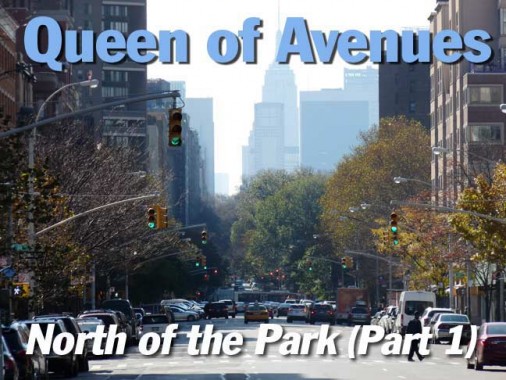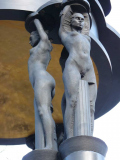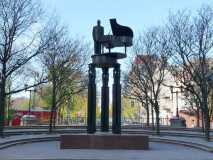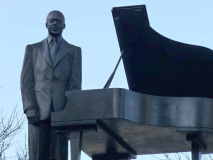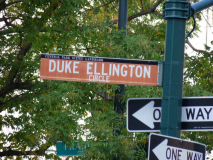Washington and Madison Squares. The King of All Buildings. St. Patrick’s Cathedral. Tiffany & Co. The east end of Central Park. The Plaza Hotel. The Metropolitan Museum of Art. The Guggenheim Museum. The Museum of the City of New York. Captain Jack McCarthy and the St. Patrick’s Day Parade. Classic lampposts. When you think of the Queen of Avenues, you think of all those things and more.
But, I do things a little differently here on Forgotten New York as you have known for over fifteen years. In November 2015, I walked the length of 5th Avenue north of Central Park all the way up to the Harlem River Drive, a part of the avenue the tour buses and walking tours don’t visit often or don’t visit at all. It’s hardly an abandoned stretch of road, but it’s usually little-remarked upon…
The intersection of 5th Avenue and East 110th Street, Central Park North, actually has accumulated three names over the years: one for a pop/jazz immortal, another for the most famous salsa performer/composer in history, and another for a construction boss/state senator/union leader.
The traffic circle here was named for Duke Ellington (1899-1974) in 1995; the composer of “Take the A Train” lived in the Upper West Side in several locations, so it’s slightly unusual that his memorial is here at an intersection on what’s technically the East Side. That’s somewhat rectified by West 106th Street’s status as Duke Ellington Boulevard.
Robert Graham’s striking 30-foot tall bronze Ellington Memorial was dedicated July 1st, 1997 and shows the Duke standing beside his piano facing east, on a pedestal supported by three columns each surmounted by three female figures meant to support Muses (in the Greek myths there were nine Muses who embodied artistic themes such as music, dance, poetry, comedy, tragedy, etc. They were the daughters of Zeus and Memory).
The work was a gift to NYC from the Duke Ellington Memorial Fund and its president in 1997, singer/pianist Bobby Short (1924-2005).
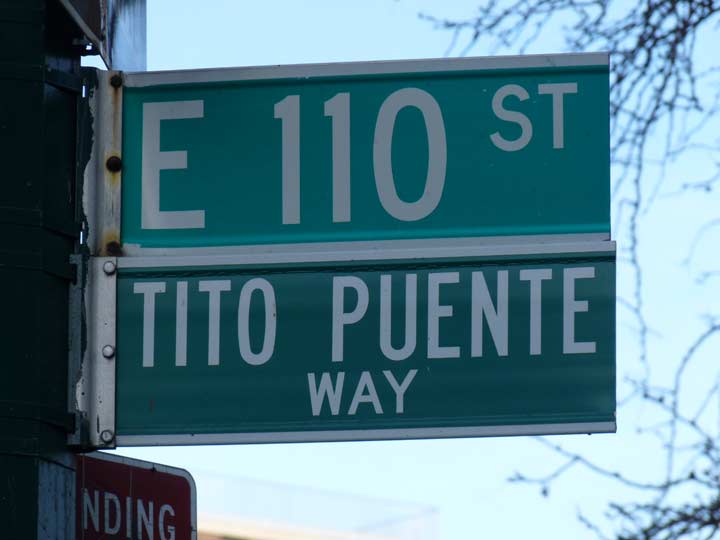
On August 20, 2000, about two months after his death, East 110th Street between 5th and Madison was co-named Tito Puente Way for the man who was synonymous with salsa (4/20/23-6/1/2000). Five-time Grammy Award winner Ernesto Antonio “Tito” Puente lived on the block as a child and youth from 1923 to 1938, and lived in Spanish Harlem for much of his life.
The intersection of 5th Avenue and 110th Street has been a roundabout, or “traffic circle,” since the late 1800s, but it was unnamed until 1926, when the Board of Aldermen (today’s City Council) named it for James J. Frawley (1867-1926), state senator, Tammany Hall district leader, and construction manger whose company built the Manhattan and Queensborough Bridges, according to Sanna Feirstein in Naming New York. At this juncture a couple of Frawley street signs remain (including a new Clearview sign), but neither supply the full name.
Seeing Frawley Circle on a street map as a kid, I incorrectly assumed that tribute was being paid to the blustering actor Bill Frawley, who played Fred Mertz on “I Love Lucy” and Bub on “My three Sons.”
I’d be unfaithful to my ongoing mission if I didn’t mention that Ellington Circle has its share of unusual lampposts, including some rare examples of Twin Type B park posts that appear on the wall surrounding the jazz king’s memorial.
In addition, Ellington Circle features these last surviving examples of leaf-scrolled “Corvingtons” that once appeared on the entire length of Central Park West and North. After a Thanksgiving Day balloon was blown into one of these posts and toppled, injuring a paradegoer in 1997, these lamps were replaced by retro versions of Twinlamps positioned parallel to Central Park West; and Central Park North received a new design placed under the aid of the organization known as the Cityscape Institute, a group devoted to beautifying New York’s sidewalks and street furniture, approximately 10 years ago.
The 35-story, twin-towered Arthur A. Schomburg Plaza, NE corner 5th Avenue and 110th Street, an apartment complex constructed in 1975 and visible from most of northern Central Park. They are two of the few octagon-shaped buildings in NYC. The complex was recently removed from the Mitchell-Lama middle class housing program.
1280 5th Avenue (a.a.a. One Museum Mile), sits at the southeast edge of the traffic circle. Architect Robert Stern included unusual trapezoidal windows in his design, completed in 2011. The front section contains space for the Museum of African Art, currently at 593 Broadway in SoHo, but it hasn’t moved in as of 2015.
Walking north on 5th Avenue from Ellington Circle isn’t promising at first, as the bland Martin Luther King and Senator Robert Taft Houses appear on the left and right, but at the NE corner of 5th and East 116th appears the faded glory of the Mount Morris Theatre, now called the Church of the Lord Jesus Christ of the Apostolic Faith, headed by the singularly named Bishop Omega Shelton. The theater opened in 1913 [Hoppin & Koen, arch.]
Likely it opened as a vaudeville playhouse, although it was showing films as early as 1917, as evidenced by a Times notice from January of that year, advertising the outrageous silent star Alla Nazimova in “War Brides.” Later in 1917, a member of the Institutional Synagogue, which held services in the building, used the stage as a platform from which to denounce the Russian Bolshevik movement. In 1934, the Mount Morris (by this time no longer owned by the Hibernians) was shut down by the city’s zealous License Commissioner, Paul Moss – reportedly because it owed its film projectionists $1,500. Gotham Lost & Found
By 1934 the Mount Morris was known as the Campoamor and later as the Cervantes, Hispano, and Radio Teatro Hispano as the area became more and more identified as Spanish Harlem. Notable performers included tango singer/songwriter Carlos Gardel and flautist Alberto Socarrás.
Edging north toward Marcus Garvey (Mount Morris) Park, the 28-story 1485 5th Avenue, or 5th on the Park, comes into view. The building broke ground in 2007 [Fox Fowle, arch.] and unusually contains a 38,000-square foot church with a 1,800-seat sanctuary for the Bethel Gospel Assembly.
An evocative sculpture by Nigerian-born painter/sculptor Nnamdi Okonkwo is mounted by the front entrance.
5th, Interrupted
5th Avenue is interrupted for four blocks by a tall rock outcropping that was never leveled by developers and engineers, as were most of other of Manhattan’s high hills. It’s indeed a tall hill: walking to the crown provides a good workout. One of the park’s main gates is located on Mount Morris Park South (120th Street) and is marked by the initials BH. What’s that, you say? Neither Marcus Garvey or Mount Morris has “BH” as initials?
The reason there is a BH on the gates is simple. The gates originally surrounded a portion of Bellevue Hospital downtown on 1st Avenue in Kips Bay, and were removed during a renovation in the 1950s; they were subsequently installed here, BH and all.
Looking south on 5th Avenue from Marcus Garvey Park, and the King of All Buildings still dominates — 82 blocks away. I used to think I was hot stuff with my 18x zoom but word comes of a camera with an 83x zoom. One of these days….
I’m part of the way up the staircase to the crown of the summit. Quoting from a Mount Morris Park page I wrote in 2009, which describes the park and its environs:
Since 1973, Mount Morris Park, located along Madison Avenue between East 120th and East 123rd Streets (it interrupts the northern progress of Fifth Avenue for 4 blocks) has been known as Marcus Garvey Park. The roadway that forms its western boundary is still called Mount Morris Park West, however, as is the immediate surrounding area in Harlem.
Native Jamaican Marcus Garvey (1887-1940) was a charismatic community leader in the early 20th Century who was an early promoter of African-American self-sufficiency; his goal was to found an independent country for African Americans in west Africa. He was found guilty of mail fraud, was deported to Jamaica in 1927 and died in exile. He remains a revered figure, however, for his founding of the UNIA in 1914 and as a promoter of social, economic and political freedom.
Land for Mount Morris Park was dedicated by the city as early as 1839 when the hill was thought to be too high to level, as many other shorter hills had been as the city’s northen limit marched up Manhattan and the street grid was established. The promontory was known by the Dutch in the colonial days as “Snake Hill” for its native reptile population.
The last remnants of “Snake Hill” east of the park, a huge rock outcropping on Park Avenue between East 122-123rd Streets, were demolished in 1911.
The name Morris turns up frequently in northern Manhattan and the Bronx. Though we’ve seen that the Bronx locales are named for the prominent Morris political dynasty, the origin of the name Mount Morris Park has apparently been a puzzler for historians. A Robert H. Morris was NYC mayor from 1841-1844, but the park had been established by then. Sanna Feirstein of Naming New York guesses that the park’s high elevation gave a good view of the Morris holdings across the Harlem River to the northeast.
Before electric lights, radio or fire alarms, when a fire broke out, you had to make a lot of noise on your own to alert the local population. Blazes were fought by volunteer fire departments, which were poorly coordinated and organized, until 1865, when the New York state legislature replaced the volunteer companies with the Metropolitan Fire Department. (The Fire Department of New York would succeed it in 1870.)
Until the fire companies acquired a telegraphic alert network in 1874, they relied on watchmen in lookout towers that were built on hills in Manhattan. The Mt. Morris fire tower is the last of its kind in NYC and the last one of its kind remaining in the USA.
Many of these towers were made of wood, and did not stand up to the elements over the years. This one, built by Julius Kroehl in 1856, is made of cast iron while the design is based on earlier towers by James Bogardus, who had built earlier such towers on 33rd street near 9th Avenue and Spring Street near MacDougal that disappeared decades ago.
How did the fire towers work? When a blaze was spotted, the watchman would then ring the bell, with different pealings indicating different neighborhoods. He would also use signal flags during the day to alert a nearby fire company. The invention of the telegraph by Samuel Morse was the first step in modern fire alerting.
The tower’s 5-ton bell was cast by founders E.A. and G.R. Meneeley of West Troy, N.Y in 1865, replacing the original 1855 bell. According to EastHarlem.com, the Mt. Morris bell continued to sound even after more modern fire alarms were installed: at noon and at 9:00 pm weekdays and 9:00 am and 9:00 pm on Sundays for timekeeping and church purposes until about 1909.
Unfortunately the ancient fire tower became unstable and thus, has been disassembled and is in storage until the Parks Department scrapes up the funds to shore it up and put it back in place. Until then, the city has substituted caesura: a forum, a “collaborative architectural and sound installation” by artist Jessica Feldman and architects Jerome W Haferd & K Brandt Knapp that was scheduled to be in place until October 31, 2015, but was held over, as I was able to get these photos on November 14, 2015.
The installation’s page defines a “caesura” (pronounced say-zura, or in the original Latin, ky-sura) as a pause or a breather. As the fire tower called firemen to action, the caesura recalls the fire tower’s original ribbed appearance (it is mounted on original fire tower stanchions) but actually has a sound system and plays speeches, rallies, chants and assemblies in Harlem in addition to sound effects like ringing bells, all magnified by transducers and construction peculiar to the artwork. The voices and sounds are especially clear when one is standing directly underneath the caesura.
I’d imagine the caesura, or something similar, will be installed in the spring if the fire tower cannot yet return.
In some ways the Marcus Garvey Park you see now is largely the same park you saw 20, 30, 40 years ago. Unfortunately that’s the rub. The park seems desperately in need of maintanance, as the concrete railings are collapsing or crumbling into dust. I imagine the steps are periodically tested for safety, but the park deserves to be a crown jewel of Harlem, and at present, it’s not.
North of Marcus Garvey Park, 5th Avenue runs north an additional 19 blocks.
And, the buildings get older and therefore better-looking, with classic attached brownstones and tidy brick townhouses. It’s hard to believe it now, but lower 5th, from Washington Square north to midtown, used to look like this, as well.
A quartet of these modular, brown metal combination stoplights and lamps is found at the intersection of 5th avenue and 125th Street (Dr. Martin Luther Kings Blvd.) Similar lamps, installed in the late 1970s or early 1980s, can be found in such disparate parts of town such as Washington Heights (West 181st) and East Flatbush (Avenue D).
The pair of buildings fronting the right side of 5th Avenue between East 125th and 126th Streets are owned by the National Black Theatre, an organization founded by professional dancer and choreographer Dr. Barbara Ann Teer (1937-2008) in 1968, as the first for-profit African-American theater arts complex in the U.S. The exterior of the theatre at street level features the work of artists from Nigeria. The street corner is subnamed for Dr. Teer’s sister Fredrica.
Artwork on East 126th Street off Fifth promoting the National Black Theatre sponsored by the nonprofit group Beats, Rhymes and Relief, which “utiliz(es) the arts to raise awareness and support for worldwide humanitarian relief efforts.”
A quatri-colored quartet of attached brownstones on the west side of 5th Avenue between West 125th and 126th.
East 126th Street between 5th and Madison Avenues. The majority of Harlem side streets feature attached brownstone buildings like this.
2050 5th Avenue, between West 126th and 127th, is the former Mt. Moriah Baptist Church, completed in 1888 [Henry F. Kilburn, arch.] It is “…graced with an array of gentle Romanesque Revival arches” according to the AIA Guide to NYC. In 2011, artist Ugo Rondinone purchased the building for $2.775M (some artists aren’t starving anymore!) and turned the entire building into an art presentation called “Monochromes” that also contained a workspace and living quarters.
The formidable Gothic Revival St. Andrew’s Episcopal Church sits at the NE corner of 5th Avenue and East 127th Street. It was built in 1872 [Henry Congdon, arch.] and is distinctive for its 125-foot tall clock tower, containing four towerlets on its four corners. It was enlarged to its present size in 1890. The parish has been in existence since 1829 — this church replaced a wood church on 127th between Park and Lexington that burned down.
Between 5th and Madison, East 127th Street is subnamed Langston Hughes Place for the poet, playwright and author (1902-1967) born in Missouri, but a Harlem resident (at #20 East 127th) during his later years after living in Cleveland and Washington, D.C. as well as traveling in Europe. He is considered a keystone of the Harlem Renaissance, the “the name given to the cultural, social, and artistic explosion that took place in Harlem, New York” in the 1920s.
Probably his most well-known work is the poem “A Dream Deferred”:
What happens to a dream deferred?/Does it dry up/Like a raisin in the sun?
Or fester like a sore–/And then run?
Does it stink like rotten meat?/Or crust and sugar over–
like a syrupy sweet?
Maybe it just sags/like a heavy load.
Or does it explode?
Next week: 5th Avenue from East 127th to the Harlem River
11/22/15
